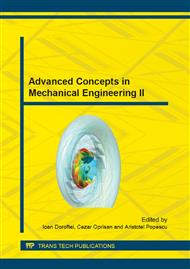p.46
p.51
p.57
p.63
p.69
p.75
p.81
p.85
p.91
Experimental Studies for Reducing Flux Consumptions in Atmospheric Controlled Brazing of Aluminum Alloys
Abstract:
Increasing performances of thermal engines and the emission reduction requirements force the functioning point of the engines to have higher temperatures, recirculation of a fraction of exhaust gases, and also higher pressure in the engine compartment. These requirements have an impact on the technical and corrosion resistance characteristics of the aluminum heat exchangers that equip these engines. Brazing technology of aluminum alloys is the most energetically effective method, having a low impact on the environment; it consists of a controlled atmosphere binding using NOKOLOK fluxes. The first downside of this method is the flux which even if is chemically inert at ambient temperature, necessitates cleaning operations at the surface of the material, the powders can become an environmental problem if they are not handled carefully; the second downside is the residual flux that resides at outlet and inlet surfaces of the brazed structure can react with the hot cooling agents giving birth to some kind of gel which can alter the heat exchanger’s functionality; the flux particles, in solid state, may detach from the surfaces and may be driven into the cooling loop leading to corrosion of the parts of which the cooling loop is composed of. This paper presents some experimental methods which reduce the flux consumption carried out at RAAL S.A. in their horizontal and vertical controlled atmosphere brazing ovens. These methods point out a significant consumption drop of flux. As a direct consequence we obtained a significant reduction of the residual flux and also the next direction of experimental investigations for obtaining a minimum flux quantity required for the brazing process to run.
Info:
Periodical:
Pages:
69-74
Citation:
Online since:
October 2014
Authors:
Keywords:
Price:
Сopyright:
© 2014 Trans Tech Publications Ltd. All Rights Reserved
Share:
Citation:


